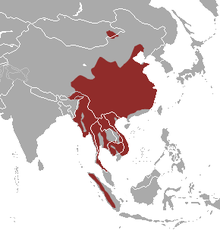Greater hog badger: Difference between revisions
BhagyaMani (talk | contribs) extended with refs + headings |
BhagyaMani (talk | contribs) →Distribution and habitat: extended with ref |
||
| Line 31: | Line 31: | ||
The following [[Subspecies (biology)|subspecies]] are recognized:<ref name=MSW3>{{MSW3 Wozencraft |id= 14001135}}</ref> |
The following [[Subspecies (biology)|subspecies]] are recognized:<ref name=MSW3>{{MSW3 Wozencraft |id= 14001135}}</ref> |
||
* Greater hog badger ''A. c. collaris'' (Cuvier, 1825) – lives in the [[Eastern Himalayas]];<ref name=ems1966>Ellerman, J. R. and Morrison-Scott, T. C. S. (1966). [http://www.archive.org/stream/checklistofindia00elle#page/274/mode/2up ''Checklist of Palaearctic and Indian mammals 1758 to 1946'']. Second edition. British Museum of Natural History, London. Pages 274–275.</ref> |
|||
* Greater Hog Badger ''A. c. collaris'' (Cuvier, 1825) |
|||
* Northern |
* Northern hog badger ''A. c. albogularis'' ([[Edward Blyth|Blyth]], 1853) – occurs in southern China northwards to [[Shensi]];<ref name=ems1966/> |
||
* Chinese |
* Chinese hog badger ''A. c. leucolaemus'' ([[Henri Milne-Edwards|Milne-Edwards]], 1867) – occurs in northern China from southern [[Kansu]] to [[Chihli]];<ref name=ems1966/> |
||
* Sumatran |
* Sumatran hog badger ''A. c. hoevenii'' ([[Ambrosius Hubrecht|Hubrecht]], 1891) – lives in Sumatra; |
||
* Indochinese |
* Indochinese hog badger ''A. c. dictator'' ([[Oldfield Thomas|Thomas]], 1910) – lives in southern Thailand and Indochina;<ref name=ems1966/> |
||
* Burmese hog badger ''A. c. consul'' ([[Reginald Innes Pocock|Pocock]], 1940) – occurs from Assam to Myanmar.<ref name=ems1966/> |
|||
== Ecology and behavior == |
== Ecology and behavior == |
||
Revision as of 16:50, 1 December 2012
| Hog badger[1] | |
|---|---|

| |
| Scientific classification | |
| Kingdom: | |
| Phylum: | |
| Class: | |
| Order: | |
| Family: | |
| Subfamily: | |
| Genus: | Arctonyx Cuvier, 1825
|
| Species: | A. collaris
|
| Binomial name | |
| Arctonyx collaris Cuvier, 1825
| |

| |
| Hog badger range | |
The hog badger (Arctonyx collaris) is a terrestrial mustelid that is widespread in Central and Southeast Asia. It is listed as Least Concern in the IUCN Red List of Threatened Species as it is occurring only patchily. The population is thought to be declining due to high levels of exploitation.[2]
Characteristics
It has medium-length brown hair, stocky body, white throat, two black stripes on an elongated white face and a pink, pig-like snout. The head-and-body length is 55–70 cm (22–28 in), the tail measures 12–17 cm (4.7–6.7 in) and the body weight is 7–14 kg (15–31 lb).[3]
Its appearance generally resembles the European badger, but it is generally smaller, with larger claws on the front feet. Its tail has long white hairs, and its front feet have white claws.
Distribution and habitat
The hog badger is found throughout southern China, Indochina, throughout Thailand and possibly in Perak, in Myanmar and in Sikkim, Assam, Arunachal Pradesh and in the Terai. There is one isolated record in eastern Mongolia. In the Indonesian island of Sumatra, the hog badger appears to occur primarily above 2,000 m (6,600 ft) with one record at 700 m (2,300 ft).[2]
The following subspecies are recognized:[1]
- Greater hog badger A. c. collaris (Cuvier, 1825) – lives in the Eastern Himalayas;[4]
- Northern hog badger A. c. albogularis (Blyth, 1853) – occurs in southern China northwards to Shensi;[4]
- Chinese hog badger A. c. leucolaemus (Milne-Edwards, 1867) – occurs in northern China from southern Kansu to Chihli;[4]
- Sumatran hog badger A. c. hoevenii (Hubrecht, 1891) – lives in Sumatra;
- Indochinese hog badger A. c. dictator (Thomas, 1910) – lives in southern Thailand and Indochina;[4]
- Burmese hog badger A. c. consul (Pocock, 1940) – occurs from Assam to Myanmar.[4]
Ecology and behavior
The hog badger is active by day and not very wary of humans.[5] Analysis of numerous camera trap pictures from Myanmar show no peak activity at either day or night.[6]
The hog badger is omnivorous, its diet consists of fruits, roots and small animals.
References
- ^ a b Wozencraft, W. C. (2005). "Order Carnivora". In Wilson, D. E.; Reeder, D. M. (eds.). Mammal Species of the World: A Taxonomic and Geographic Reference (3rd ed.). Johns Hopkins University Press. pp. 532–628. ISBN 978-0-8018-8221-0. OCLC 62265494.
- ^ a b c Template:IUCN
- ^ Boitani, L. (1984). Simon & Schuster's Guide to Mammals. Touchstone. ISBN 978-0-671-42805-1
- ^ a b c d e Ellerman, J. R. and Morrison-Scott, T. C. S. (1966). Checklist of Palaearctic and Indian mammals 1758 to 1946. Second edition. British Museum of Natural History, London. Pages 274–275.
- ^ Duckworth, J. W., Salter, R. E. and Khounbline, K. (1999). Wildlife in Lao PDR: 1999 Status Report. IUCN, Vientiane, Laos.
- ^ Than Zaw, Saw Htun, Saw Htoo Tha Po, Myint Maung, Lynam, A. J., Kyaw Thinn Latt and Duckworth, J. W. (2008). Status and distribution of small carnivores in Myanmar. Small Carnivore Conservation 38: 2–28.

